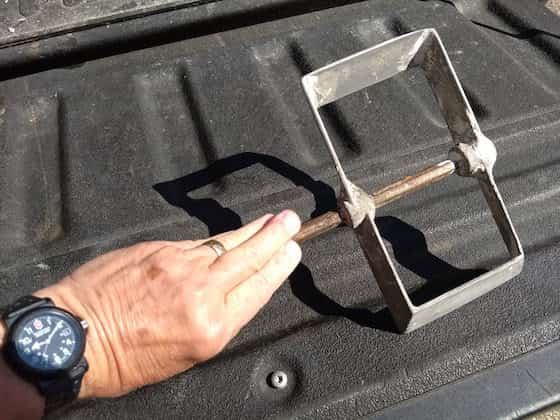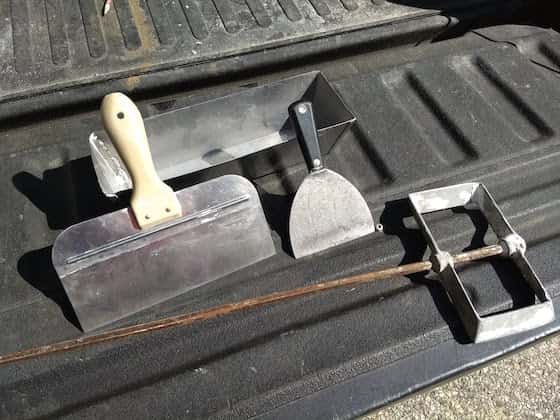Ten Secret Drywall Finishing Tips

How to finish drywall you ask. Drywall finishing may look easy, but it requires a deft touch. This small section of wall has just about every drywall finish challenge in it: flat and tapered seams, inside and outside corners and an archway! Copyright 2018 Tim Carter
"Drywall finishing requires hand-eye coordination. Some people have it and others simply don't. One of my employees couldn't finish drywall to save his life."
Secret Drywall Finishing TIPS
- The joint compound must be creamy like pudding
- Leave 1/16-inch layer of mud between drywall and paper tape
- Don't try for perfection during second coat
- WATCH my drywall finishing videos below!
- CLICK HERE to Get Tim's FREE & FUNNY Newsletter
How To Finish Drywall?
You finish drywall with great skills. It takes lots of practice to get professional drywall finishing results. Even if you follow my ten drywall finishing tips that follow, you may not get professional results.
Why? Drywall finishing requires hand-eye coordination.
Some people have it and others simply don't. One of my employees couldn't finish drywall to save his life. I tried and tried to get him to hold the broad knife the right way, but he never could get just the right smooth gliding motion with that knife.
Related Links
Drywall Taping Blisters - Second Biggest Rookie Mistake
The Truth About Drywall and Wet Locations
CLICK HERE to get FREE & FAST BIDS from drywall finishing pros in your town.
How Are Drywall Taping and Mudding Skills Acquired?
Drywall taping and mudding skills are acquired by lots of practice. You need to be trained by a professional or watch a few of my videos below.
It's important to realize this is a talent that's acquired. It's much like driving. You get to where you know the feel of a car and a road surface.
Finishing drywall is the same. You get a feel for the flexibility of certain tools and the consistency of the joint compound. I say we give it a try. Here are my Ten Tips:
Does the Drywall Need to be Hung Well?
Great drywall finishes begin with superior hanging jobs. The drywall must be tight against the wall studs or the ceiling joists. All screws need to be countersunk just enough to where they do not tear the paper.
There need to be enough fasteners. I like to see screws every 16 inches on walls and every 12 inches on center on ceilings. Tapered seams should be tight. Corner joints or other joints should have a gap of approximately 1/4 inch. A tight seam is best but a slight gap is acceptable.
How Do You Mix the Mud?
You mix drywall mud by adding a small amount of water and then stir it with a paddle attached to a power drill.

This is my joint compound mixing paddle. It has a long shaft that you insert into a drill. CLICK THE PHOTO NOW to have one delivered to your home. Copyright 2018 Tim Carter
Most people use pre-mixed mud in a bucket or a box. This mud is simply too stiff to use. You need to add a little water and whip the mud up to the consistency of creamy cake icing.
It must be lump free. Be careful not to mix too much air into it. If you do, sometimes you get tiny air bubbles in your seams as you apply and finish the mud. Just try to mix the mud slowly. Do NOT add too much water.
Watch this video to see what the mud should look like:
Paper or Mesh Tape?
I have used both. I prefer to use the paper tape in corners and the self-adhesive mesh tape is superb for tapered seams. I will use paper for both with no hesitation. If you have lots of taping to do, fabricate a belt holder using a coat hanger that holds the roll of tape. Or you can buy a handy holder at a drywall supply house.
What are the Best Drywall Finishing Tools?
The best drywall finishing tools are:
- a stainless-steel mud pan
- a 10-inch stainless-steel broadknife
- a 5-inch wide taping knife

These are my favorite drywall finishing tools. CLICK THE PHOTO to have them delivered to your home. Copyright 2018 Tim Carter
I prefer stainless steel broad knives for finishing. I have 10 and 12-inch knives. For taping, I use a flexible steel blade that is about 5 inches wide. My trusty one that's over 25-years old is not stainless steel, but you can now get them.
It's important to use a file to slightly round off the corners of your taping knife. A brand new knife has very sharp corners and they will tear the paper tape as you glide it down a corner seam.
What are the Drywall Finishing Steps?
Here are the drywall finishing steps:
- tape flat seams
- do inside corners walls and ceilings
- tape corner bead corners (see video below)
- coat corner bead
- second coat
- light sand second coat ridges
- third coat and skim
I do all of my flat seams first and run the tape to within one-half inch of the corners. I then do the inside corners last so that this tape overlaps the flat seam tape. Before you start to tape, all metal and curved corner bead should be nailed in place.
How Do You Tape Drywall by Hand?
On flat seams, I will apply mud to just about four or five linear feet of seam. I do the same in corners.
I press the tape in place and start to scrape the seam to remove excess mud. I stop about six inches from the end of the excess mud. I then apply more mud to the drywall to proceed.
When Do You Apply the Second Coat of Mud?
You can second coat immediately after you have finished taping. The tape does not have to be dry. It will dry out as the second coat dries.
How Do You Second Coat Inside Corners?
You second coat inside corners one side at a time.
You can't apply the second coat of mud on both sides of a corner at the same time. You do one side on one day and then the other side on day two or after the mud is dry.
You can finish three corner surfaces where a ceiling meets the inside corner of two walls at the same time. If I was looking at an inside corner I could do the right side vertical wall seam of the inside corner, the ceiling side of the right wall/ceiling intersection and the top wall side of the left wall/ceiling intersection.
On the following day, you would coat the remaining three corner surfaces. Corner tape should have a 1/16th-inch layer of mud over the tape once complete.
Does the Second Coat Have to be Perfect?
No, the second coat of mud does not have to be perfect. You should have a slight ridge in the center of taped seams. This ridge gets sanded off later.
Everyone tries to get the second coat perfect! Big Mistake!
The feathered edges where the mud stops and the drywall paper begins must be clean with no excess and the mud must build up from there to a high point at the center of wall and ceiling seams. You will see this ridge line and any lift marks where you pull the knife away from the wall.
Once the mud dries you will quickly sand these off before applying the third coat of mud.
Should Drywall be Primed and Sealed?
Yes, finished drywall should be primed and sealed. This paint coating evens out the porosity and texture of the drywall so the finished paint looks superb.
After you have third coated and finally sanded the seams, corners, and nails, you MUST apply a superb sealer/primer to the walls before you paint. USG Corp makes a fantastic inexpensive paint called First Coat®.
It's ideal. It eliminates joint banding and texture problems that happen when the regular paint is applied to freshly finished drywall. The primer sealer is applied like any other paint and looks milky as you roll it.
But somehow an hour later the wall is snow white! Failure to apply a primer/sealer before painting will negate all of your hard work.
Column B387


27 Responses to Ten Secret Drywall Finishing Tips